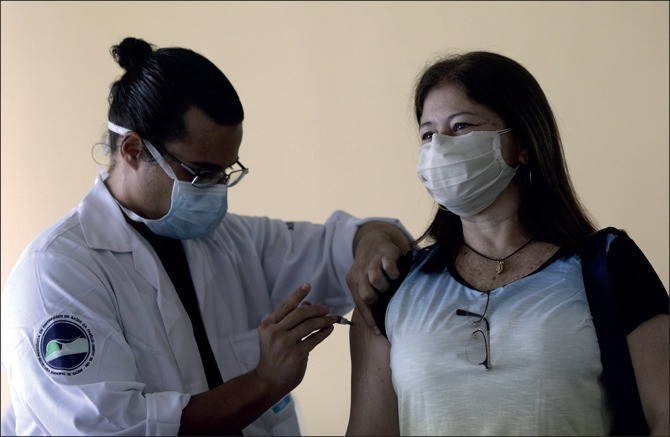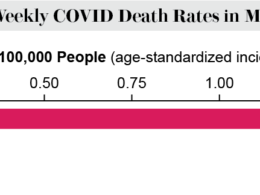This is a republication of the paper below, with the title above, suggested by the Editor of the Blog.
Managing waning vaccine protection against SARS-CoV-2 variants
The Lancet
Kathy Leung, Joseph T Wu
December 20, 2021
Key messages
- Vaccine protection of two-dose ChAdOx1 nCoV-19 (Oxford — AstraZeneca) wanes substantially within 21 weeks, even in the absence of new VOCs, and hence is an important driver for the increased number of severe cases in populations that have been vaccinated with two-dose ChAdOx1 nCoV-19.
- … the finding that protection with ChAdOx1 nCoV-19 (Oxford — AstraZeneca) wanes is crucial, because ChAdOx1 nCoV-19 is one of the most widely used vaccines and its effectiveness against the omicron variant has yet to be characterised.
- Better understanding about waning protection of different vaccines would help inform the design and update of vaccination policy, especially for LMICs and in anticipation of further emergence of new VOCs.
Less than 2 years after its emergence, the COVID-19 pandemic has caused more than 5 million deaths worldwide. The expeditious development of safe and effective vaccines against COVID-19 brings hope that the world could soon return to pre-pandemic normality if vaccine uptake is sufficiently high. However, uncertainty about the duration of vaccine protection and the emergence of SARS-CoV-2 variants of concern (VOCs) have added complexities to the path to recovery. The recent emergence of variants such as delta (B.1.617.2) and omicron (B.1.1.529) are particularly worrying because of their higher transmissibility and greater immune escape potential compared with other lineages.
Thus, for locations that have had an apparent increase in breakthrough infections in vaccinated populations, there is a great and urgent need to understand the underlying contributing factors (waning of vaccine protection, vaccine escape of VOCs, and relaxation of public health and social measures, etc). An understanding of these contributing factors is particularly important for informing vaccination policy in many low-income and middle-income countries (LMICs) where vaccine availability and hence primary vaccination coverage remain low (eg, Nigeria, Pakistan, and South Africa).
In The Lancet, Srinivasa Katikireddi and colleagues report their analysis of national health databases from Scotland and Brazil assessing temporal changes in vaccine protection of two doses of ChAdOx1 nCoV-19 against confirmed symptomatic infection and severe COVID-19.
This retrospective, population-based cohort study was based on data collected before the omicron variant emerged. 1 972 454 adults received two doses of ChAdOx1 nCoV-19 ((Oxford — AstraZeneca) in Scotland and 42 558 839 adults received two doses in Brazil.
Katikireddi and colleagues found consistent waning of vaccine protection in both countries despite differential circulating VOCs (ie, delta in Scotland, and gamma and delta in Brazil) and found temporal trends in COVID-19 infection risks.
In Scotland, rate ratios (RRs) for severe COVID-19 increased to 2·01 (95% CI 1·54–2·62) at 10–11 weeks, 3·01 (2·26–3·99) at 14–15 weeks, and 5·43 (4·00–7·38) at 18–19 weeks after the second dose.
Similarly, in Brazil there were RRs of 2·29 (2·01–2·61) at 10–11 weeks, 3·10 (2·63–3·64) at 14–15 weeks, and 4·71 (3·83–5·78) at 18–19 weeks after the second dose.
In Scotland, vaccine effectiveness decreased from 83·7% (95% CI 79·7–87·0) at 2–3 weeks to 75·9% (72·9–78·6) at 14–15 weeks and 63·7% (59·6–67·4) at 18–19 weeks after the second dose. I
n Brazil, vaccine effectiveness decreased from 86·4% (85·4–87·3) at 2–3 weeks, to 59·7% (54·6–64·2) at 14–15 weeks, and 42·2% (32·4–50·6) at 18–19 weeks.
These findings suggest that vaccine protection of two-dose ChAdOx1 nCoV-19 (Oxford — AstraZeneca) wanes substantially within 21 weeks, even in the absence of new VOCs, and hence is an important driver for the increased number of severe cases in populations that have been vaccinated with two-dose ChAdOx1 nCoV-19.
… vaccine protection of two-dose ChAdOx1 nCoV-19 wanes substantially within 21 weeks, even in the absence of new VOCs, and hence is an important driver for the increased number of severe cases in populations that have been vaccinated with two-dose ChAdOx1 nCoV-19.
Several methodological caveats should be noted when interpreting these study findings.
First, although Katikireddi and colleagues have made an extensive effort to adjust for the differences in population structures, transmission dynamics, and vaccine uptake between Scotland and Brazil, some confounding factors might remain. For example, ChAdOx1 nCoV-19 was administered mainly to older people in Scotland between late 2020 and early 2021, whereas there were no specific target age groups in Brazil.
Second, although people with confirmed previous SARS-CoV-2 infection were excluded from the analysis, natural immunity from mild or asymptomatic infections might not have been identified and accounted for. Such immunity was likely to be prevalent in Brazil and Scotland because both countries had had several substantial waves of COVID-19 before 2021.
Third, the estimates of vaccine effectiveness and the magnitude of waning protection (ie, RRs in this study) should be interpreted with caution owing to challenges in estimating risk of infection and severe outcomes among vaccinated and unvaccinated individuals in observational studies.
Notwithstanding these methodological limitations, the finding that protection with ChAdOx1 nCoV-19 (Oxford — AstraZeneca) wanes is crucial, because ChAdOx1 nCoV-19 is one of the most widely used vaccines and its effectiveness against the omicron variant has yet to be characterised.
Preliminary data show that the antibodies from a three-dose course of mRNA vaccines neutralise omicron, although all the studies report a notable drop in neutralising antibody titres compared with earlier variants such as delta.,
These data suggest that the effectiveness of mRNA vaccines against severe disease and death might be retained.
However, there are limited data about the effectiveness of other vaccines against omicron, let alone data about heterologous vaccination and boosters.
Better understanding about waning protection of different vaccines would help inform the design and update of vaccination policy, especially for LMICs and in anticipation of further emergence of new VOCs.
… the finding that protection with ChAdOx1 nCoV-19 (Oxford — AstraZeneca) wanes is crucial, because ChAdOx1 nCoV-19 is one of the most widely used vaccines and its effectiveness against the omicron variant has yet to be characterised.
Better understanding about waning protection of different vaccines would help inform the design and update of vaccination policy, especially for LMICs and in anticipation of further emergence of new VOCs.
References
See the original publication
Originally published at https://www.thelancet.com.












